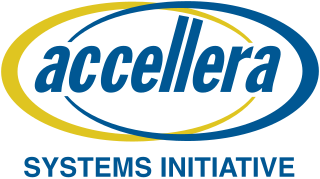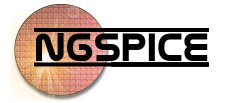
An integrated circuit or monolithic integrated circuit is a set of electronic circuits on one small flat piece of semiconductor material, usually silicon. Large numbers of tiny MOSFETs integrate into a small chip. This results in circuits that are orders of magnitude smaller, faster, and less expensive than those constructed of discrete electronic components. The IC's mass production capability, reliability, and building-block approach to integrated circuit design has ensured the rapid adoption of standardized ICs in place of designs using discrete transistors. ICs are now used in virtually all electronic equipment and have revolutionized the world of electronics. Computers, mobile phones and other home appliances are now inextricable parts of the structure of modern societies, made possible by the small size and low cost of ICs such as modern computer processors and microcontrollers.
Electronic design automation (EDA), also referred to as electronic computer-aided design (ECAD), is a category of software tools for designing electronic systems such as integrated circuits and printed circuit boards. The tools work together in a design flow that chip designers use to design and analyze entire semiconductor chips. Since a modern semiconductor chip can have billions of components, EDA tools are essential for their design; this article in particular describes EDA specifically with respect to integrated circuits (ICs).

Magma Design Automation was a software company in the electronic design automation (EDA) industry. The company was founded in 1997 and maintained headquarters in San Jose, California, with facilities throughout North America, Europe and Asia. Magma software products were used in major elements of Integrated circuit design, including: synthesis, placement, routing, power management, circuit simulation, verification and analog/mixed-signal design.
Silicon on sapphire (SOS) is a hetero-epitaxial process for metal-oxide-semiconductor (MOS) integrated circuit (IC) manufacturing that consists of a thin layer (typically thinner than 0.6 µm) of silicon grown on a sapphire (Al2O3) wafer. SOS is part of the silicon-on-insulator (SOI) family of CMOS (complementary MOS) technologies.

Accellera Systems Initiative (Accellera) is a standards organization that supports a mix of user and vendor standards and open interfaces development in the area of electronic design automation (EDA) and integrated circuit (IC) design and manufacturing. It is less constrained than the Institute of Electrical and Electronics Engineers (IEEE) and is therefore the starting place for many standards. Once mature and adopted by the broader community, the standards are usually transferred to the IEEE.
VLSI Technology, Inc., was an American company that designed and manufactured custom and semi-custom integrated circuits (ICs). The company was based in Silicon Valley, with headquarters at 1109 McKay Drive in San Jose. Along with LSI Logic, VLSI Technology defined the leading edge of the application-specific integrated circuit (ASIC) business, which accelerated the push of powerful embedded systems into affordable products.

OrCAD Systems Corporation was a software company that made OrCAD, a proprietary software tool suite used primarily for electronic design automation (EDA). The software is used mainly by electronic design engineers and electronic technicians to create electronic schematics, perform mixed-signal simulation and electronic prints for manufacturing printed circuit boards (PCBs). OrCAD was taken over by Cadence Design Systems in 1999 and was integrated with Cadence Allegro since 2005.

Integrated circuit design, or IC design, is a sub-field of electronics engineering, encompassing the particular logic and circuit design techniques required to design integrated circuits, or ICs. ICs consist of miniaturized electronic components built into an electrical network on a monolithic semiconductor substrate by photolithography.
An EDA database is a database specialized for the purpose of electronic design automation. These application specific databases are required because general purpose databases have historically not provided enough performance for EDA applications.

Ngspice is an open-source mixed-level/mixed-signal electronic circuit simulator. It is a successor of the latest stable release of Berkeley SPICE, version 3f.5, which was released in 1993. A small group of maintainers and the user community contribute to the ngspice project by providing new features, enhancements and bug fixes.
The Si2 Common Power Format, or CPF is a file format for specifying power-saving techniques early in the design process. In the design of integrated circuits, saving power is a primary goal, and designers are forced to use sophisticated techniques such as clock gating, multi-voltage logic, and turning off the power entirely to inactive blocks. These techniques require a consistent implementation in the design steps of logic design, implementation, and verification. For example, if multiple different power supplies are used, then logic synthesis must insert level shifters, place and route must deal with them correctly, and other tools such as static timing analysis and formal verification must understand these components. As power became an increasingly pressing concern, each tool independently added the features needed. Although this made it possible to build low power flows, it was difficult and error prone since the same information needed to be specified several times, in several formats, to many different tools. CPF was created as a common format that many tools can use to specify power-specific data, so that power intent only need be entered once and can be used consistently by all tools. The aim of CPF is to support an automated, power-aware design infrastructure.
SKILL is a Lisp dialect used as a scripting language and PCell description language used in many EDA software suites by Cadence Design Systems. It was originally put forth in an IEEE paper in 1990.

Multi-project chip (MPC), and multi-project wafer (MPW) semiconductor manufacturing arrangements allow customers to share mask and microelectronics wafer fabrication cost between several designs or projects.

Cadence Design Systems, Inc., headquartered in San Jose, California, is an American multinational computational software company, founded in 1988 by the merger of SDA Systems and ECAD, Inc. The company produces software, hardware and silicon structures for designing integrated circuits, systems on chips (SoCs) and printed circuit boards.
The Compact Model Coalition is a working group in the Electronic Design Automation industry formed to choose, maintain and promote the use of standard semiconductor device models. Commercial and industrial analog simulators need to add device models as technology advances and earlier models become inaccurate. Before this group was formed, new transistor models were largely proprietary, which severely limited the choice of simulators that could be used.
PathWave Design is a division of Keysight Technologies that was formerly called EEsof. It is a provider of electronic design automation (EDA) software that helps engineers design products such as cellular phones, wireless networks, radar, satellite communications systems, and high-speed digital wireline infrastructure. Applications include electronic system level (ESL), high-speed digital, RF-Mixed signal, device modeling, RF and Microwave design for commercial wireless, aerospace, and defense markets.
This page is a comparison of electronic design automation (EDA) software which is used today to design the near totality of electronic devices. Modern electronic devices are too complex to be designed without the help of a computer. Electronic devices may consist of integrated circuits (ICs), printed circuit boards (PCBs), field programmable gate arrays (FPGAs) or a combination of them. Integrated circuits may consist of a combination of digital and analog circuits. These circuits can contain a combination of transistors, resistors, capacitors or specialized components such as analog neural networks, antennas or fuses.
IC Manage is a company that provides design data and IP management, Big Data Analytics, Hybrid Cloud Bursting, and High-Performance Computing software to semiconductors, systems, Internet of Things and artificial intelligence IC companies.

ODB++ is a proprietary CAD-to-CAM data exchange format used in the design and manufacture of electronic devices. Its purpose is to exchange printed circuit board design information between design and manufacturing and between design tools from different EDA/ECAD vendors. It was originally developed by Valor Computerized Systems, Ltd. as the job description format for their CAM system.
Glossary of microelectronics manufacturing terms








